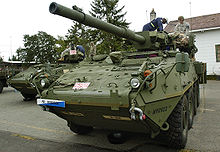Stryker Brigade Combat Team
A Stryker Brigade Combat Team (SBCT) is a reinforced brigade ( Brigade Combat Team ) of the US Army with approx. 3900 soldiers and thus the second largest variant of the three combat brigade types of the Army and was first set up in 2002. The peculiarity of the Stryker brigades is their transport and combat means, the Stryker , a four-axle 8x8 - Radpanzer and the associated global deployability within 96 hours (with transport aircraft of type C-5 Galaxy , C-17 Globemaster III and C-130 Hercules ).
history
As part of the transformation of the United States Army , the concept of the Stryker Brigade Combat Teams was developed and implemented for the first time in 2002. The first combat deployment and deployment of a Stryker Brigade Combat Team took place in 2003 when a brigade of this type was deployed to Iraq (near Mosul ).
The implementation of this new brigade concept since 1997 should actually be completed by 2005, but is still ongoing and is expected to be completed by 2009. The usual approval procedure as well as the military conflicts that were going on at the time led to delays in procurement. It led and leads not only to a standardization of the individual combat brigades within the divisions , but also to a reduction in "frictional losses" in the command structure and in the flow of information between the individual branches of the military within the major military unit. By streamlining the communication channels, for example through its own reconnaissance and fire support elements within the brigade, target setting and combat strength were optimized so that parts of the support elements could also be saved. The only combat support the division still needs from outside is that of the Air Force or the US Navy .
organization
Since the concept of the Stryker Brigades was introduced before Gen. Peter J. Schoomaker , the intellectual father of army reform (transformation) , a Stryker Brigade Combat Team has three combat battalions plus one reconnaissance battalion instead of two . As a result, this type of brigade also has the second largest workforce in the US combat brigades, because the Armored Brigade Combat Teams (ABCT) (heavy tank brigades) consist of approx. 4200 soldiers and the Infantry Brigade Combat Teams (IBCT) (infantry brigades) consist of around 3200. A Stryker Brigade Combat Team has up to 300 Stryker armored vehicles.
composition
- Headquarters Company ( HQ Company )
- Reconnaissance, surveillance, and target acquisition squadron (reconnaissance battalion) with three reconnaissance companies with 14 Stryker RVs and two Stryker MCs each, a drone reconnaissance platoon and two 120 mm mortar reconnaissance platoons .

- 3 Stryker infantry battalions consisting of three infantry companies each with twelve Stryker ICV [troop transports], three Stryker MGS [cannon platforms] and two Stryker MC [120 mm mortars], a reconnaissance platoon, a medical platoon and a sniper group .
- Anti-tank company ( anti-tank company with nine Strykers with the TOW anti-tank system )
- Fires battalion (artillery battalion with three batteries each with six M777 155 mm howitzers as well as a fire support train and a fire control train)
- Engineer Company ( pioneer company)
- Signal Company (telecommunications company)
- Military Intelligence Company ( intelligence reconnaissance company with its own drone reconnaissance platoon )
- Support Battalion ( support battalion with transport, repair and medical company)
Current Stryker Brigade Combat Teams
There are currently nine brigades of this type in service in the Army, including one as an independent unit, another six as active brigades of divisions and two brigades of the Army National Guard .
- Independent brigades
-
 2nd Cavalry Regiment , (independent brigade) in Vilseck ( Grafenwoehr military training area ).
2nd Cavalry Regiment , (independent brigade) in Vilseck ( Grafenwoehr military training area ).
- Active division brigades
-
 1st Stryker Brigade Combat Team , (part of 4th Infantry Division ) in Fort Carson , Colorado
1st Stryker Brigade Combat Team , (part of 4th Infantry Division ) in Fort Carson , Colorado
-
 1st Stryker Brigade Combat Team , (part of 25th Infantry Division ) in Fort Wainwright , Alaska
1st Stryker Brigade Combat Team , (part of 25th Infantry Division ) in Fort Wainwright , Alaska
-
 2nd Stryker Brigade Combat Team , (part of the 25th Infantry Division ), in the Schofield Barraks Hawaii
2nd Stryker Brigade Combat Team , (part of the 25th Infantry Division ), in the Schofield Barraks Hawaii
-
 2nd Stryker Brigade Combat Team , Strikeforce , (part of 2nd Infantry Division / formerly 5th BCT), in Fort Lewis , Washington
2nd Stryker Brigade Combat Team , Strikeforce , (part of 2nd Infantry Division / formerly 5th BCT), in Fort Lewis , Washington
-
 3rd Stryker Brigade Combat Team, Arrowhead Brigade , (part of 2nd Infantry Division ) stationed in Fort Lewis, Washington.
3rd Stryker Brigade Combat Team, Arrowhead Brigade , (part of 2nd Infantry Division ) stationed in Fort Lewis, Washington.
- 4th Stryker Brigade Combat Team. ( Part of 2nd Infantry Division ) based in Fort Lewis, Washington.
- Army National Guard
- 56th Stryker Brigade Combat Team ( part of 28th Infantry Division ) stationed at Horsham Air Guard Station, Pennsylvania (Pennsylvania Army National Guard)
- 81st Stryker Brigade Combat Team ( part of 7th Infantry Division ) based in Seattle , Washington (Washington, Oregon and California Army National Guard)
Web links
- Andrew Feickert: US Army's Modular Redesign: Issues for Congress. (PDF; 118 kB) Congressional Research Service, Library of Congress, May 5, 2006, accessed on September 20, 2007 (English).
- SBCTs at globalsecurity.org (English)
- Stryker Brigade News (English)
Individual evidence
- ^ Army announces conversion of two brigade combat teams. In: www.army.mil. U.S. Army Public Affairs, September 21, 2018, accessed April 11, 2020 .



